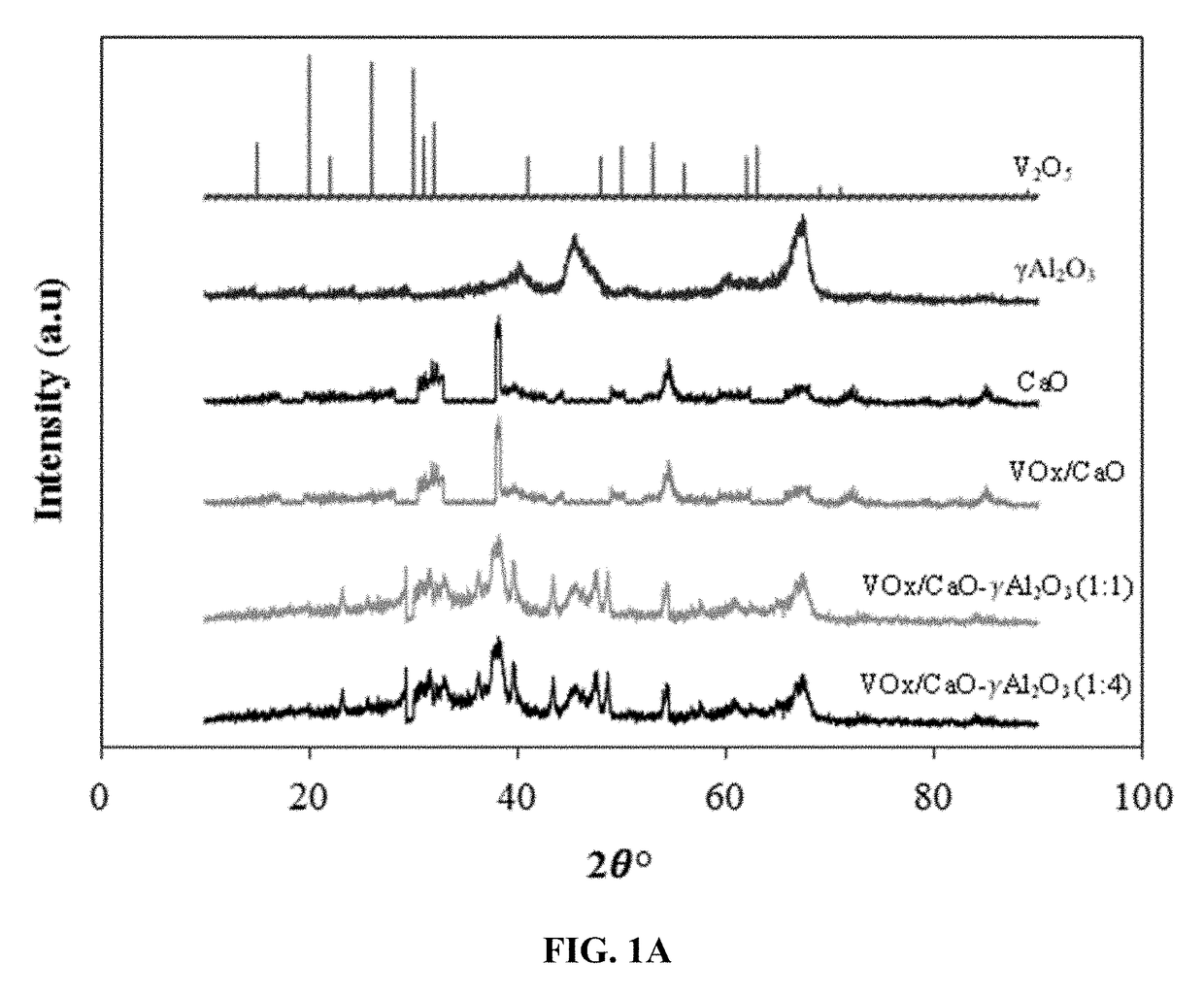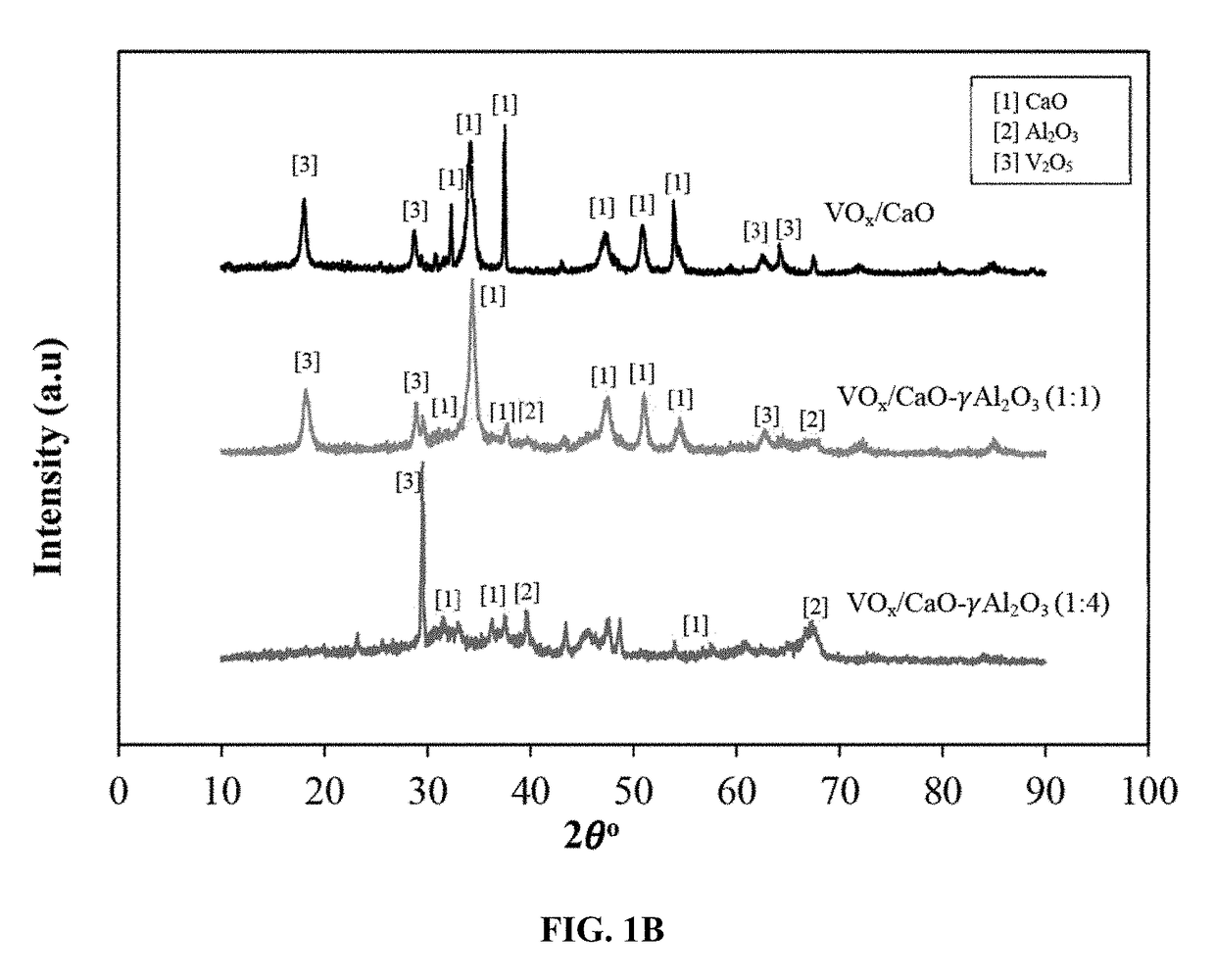Fluidizable vanadium catalyst for oxidative dehydrogenation of alkanes to olefins in a gas phase oxygen free environment
a vanadium catalyst and alkane technology, applied in the direction of metal/metal-oxide/metal-hydroxide catalyst, organic compound preparation, hydrocarbon preparation, etc., can solve the problem of consuming a large amount of heat energy in steam cracking process, reducing the efficiency of the process, and reducing the production cos
- Summary
- Abstract
- Description
- Claims
- Application Information
AI Technical Summary
Benefits of technology
Problems solved by technology
Method used
Image
Examples
example 1
Catalyst Synthesis
[0113]The catalyst samples were prepared by an impregnation method through soaking with excess ethanol as solvent. The support material γ-Al2O3 (surface area of 141 m2 / g) was received from Inframat Advanced Materials, Manchester, UK, while CaO (surface area of 4 m2 / g) was received from Loba Chemie, India. Before metal loading, the γ-Al2O3 and CaO supports were calcined under pure N2 flow at 500° C. for 4 hours to remove moisture and volatile compounds. The calcined γ-Al2O3 sample was place in a beaker and ethanol was added. A desired amount of vanadyl acetyl acetonate and CaO were then added to the beaker and the mixture was left under stirring for 12 hours. The mixture was then placed under sonication for 10 minutes. The mixture was filtered and dried at room temperature under atmospheric conditions evaporating ethanol. Following the natural evaporation and drying, the sample was placed in an oven at 100° C. for 24 hours in order to slowly remove any remaining sol...
example 2
X-Ray Diffraction (XRD) Analysis and Characterization of the Prepared Catalysts
[0114]The crystallographic structure of the catalyst samples and the bare supports were investigated using X-ray diffraction (XRD) analysis. The XRD patterns of all the samples were recorded on a Rigaku Miniflex diffractometer with monochromatic Cu Kα radiation of 1.5406×10−1 nm wavelength, an electrical current of 50 mA, an electrical voltage of 10 kV and a scan rate of 2° per minute (normal scan rate) within the 2θ range from 10°-90° with a 0.02 step size.
[0115]FIG. 1A shows the XRD patterns of the three VOx / CaO-γ-Al2O3 catalyst samples (different CaO / γ-Al2O3 ratios) as well as bare CaO support, bare γ-Al2O3 support, and V2O5 for comparison. The XRD pattern of V2O5 shows well defined crystal structures at 2θ angles of 12.8°, 17.4°, 19.7°, 24.1°, 28.2°, 43.3°, and 48.2°. The γ-Al2O3 samples give two peaks at 2θ angles of 48° and 67°, which are consistent with previous studies. The XRD pattern of CaO show...
example 3
Laser Raman Spectroscopy Analysis and Characterization of the Prepared Catalysts
[0117]The molecular structures of various metal oxide species supported on CaO-γ-Al2O3 and CaO were analyzed using a Horiba Raman spectrometer attached to a confocal microscope. For each experiment, 0.5 g of sample was dehydrated under dry air for an hour at 500° C. and then cooled to ambient temperature. Each sample was analyzed using a Raman spectrometer with a thermoelectrically cooled CCD detector (−73° C.). An argon ion laser line of 532 nm wavelength was used to excite the catalyst samples. The Raman spectrometer was used for measuring and recording the spectra produced from the excitation with a resolution of 1 cm−1 at room temperature.
[0118]FIG. 2A presents the Raman spectra of the samples that were obtained at ambient temperature. FIG. 2B also includes the Raman spectra of bare CaO and γ-Al2O3 supports and V2O5 samples. The Raman spectra analysis indicates that all of the three catalyst samples ...
PUM
| Property | Measurement | Unit |
|---|---|---|
| particle size | aaaaa | aaaaa |
| particle density | aaaaa | aaaaa |
| temperature | aaaaa | aaaaa |
Abstract
Description
Claims
Application Information
 Login to View More
Login to View More - R&D
- Intellectual Property
- Life Sciences
- Materials
- Tech Scout
- Unparalleled Data Quality
- Higher Quality Content
- 60% Fewer Hallucinations
Browse by: Latest US Patents, China's latest patents, Technical Efficacy Thesaurus, Application Domain, Technology Topic, Popular Technical Reports.
© 2025 PatSnap. All rights reserved.Legal|Privacy policy|Modern Slavery Act Transparency Statement|Sitemap|About US| Contact US: help@patsnap.com



